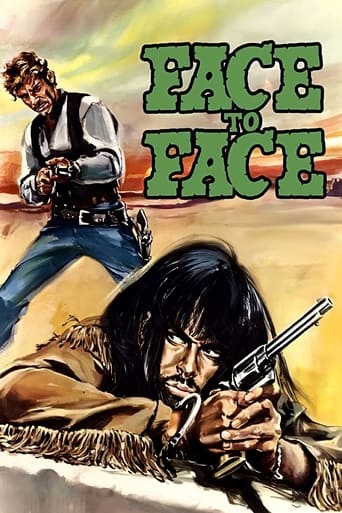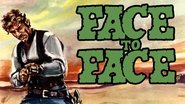Bezenby
It's Breaking Bad - The Western! Check this out: A teacher, who feels he hasn't made much of a mark in life, is stricken with a chronic lung condition and heads south to the Mexican border, where he is seduced by a life of crime and the power that comes with it. Being an educated man, he thinks he can outsmart everyone and although it works for a while, his greed and egotistical nature lead to his downfall.That's Breaking Bad, right? (Err...spoilers for those who haven't watched that). Gian Maria Volonte is the mild mannered teacher. Tomas Milian is his reluctant mentor, a screaming, filth covered bandit who for some reason has the haircut of Dave Hill of Slade. Milian's jaded with the life and doesn't want Volonte involved, but Volonte manages to wangle his way into Milian's gang, as does William Berger, who is a cold-eyed Pinkerton man with his eye on the bounty of all these bandits...This one doesn't play out so much like your typical Western either. There's plenty of gunfights, the best of which is a botched robbery, but it's all about Volonte and Milian (and to a lesser degree, Berger). You'll either love or hate their shouting, foaming at the mouth way of acting I guess. Berger's a bit more laid back here (although he could act nuts too). Plus there's the usual game of 'hey, wasn't that guy in...' that you can play with the extras.From what I read this was Sollima's favourite film, and I can see why - it's more philosophical than action packed, and was perhaps a parable on the rise of fascism in Italy? Don't know enough about that myself mind you...
GUENOT PHILIPPE
Among those who know my tastes, many will be surprised that I say a spaghetti western is a masterpiece. Because I hate spaghetti westerns. I hate the pace, music, zooms and other camera angles, I hate actors, gun shots and fists fights sounds. I hate everything in spaghetti westerns, especially if they tell the exact same schemes which the American ones already bring to us. I speak of the good guys vs evil guys schemes. With the expected f...happy ending. BUT But if the spaghetti westerns bring us something different from the SCREENPLAY and ONLY the screenplay, such as this one or for instance THE GREAT SILENCE and a handful of others, with no happy f...endings, then I can be highly interested in spaghetti westerns. This said, I won't add much to the other comments, this film was a true delight for me. The topic reminded me James B Clark's ONE FOOT IN HELL or Spencer G Bennet's BOUNTY KILLER where the main characters - Alan Ladd for the first and Dan Duryea for the second - began as the good guys in the beginning and then slowly became bad as the story resumed. You had here very excellent character's study with a good focus on their psychology. And very sad stories too. That's what I love. Nothing else.
zardoz-13
Most Spaghetti westerns concern themselves with rituals, like elaborate showdowns, but "Big Gundown" director Sergio Sollima has written an above-average, rather intelligent Italian oater with Sergio Donati that relies as much on characterization as it does violence to make its points. Intellectual Boston history professor Brad Fletcher (Gian Maria Volonte of "Fistful of Dollars")quits teaching and heads out west for the salubrious climate. No sooner has he crossed the Mississippi than he runs afoul of a lawman escorting the notorious outlaw, Solomon "Beauregard" Bennet(Tomas Milian of "Companeros"), and he intervenes out of mercy to give the poor wretch a drink. This entire scene reminded me of "Ben-Hur" with one man providing water to another less fortunate. Bennett catches his escort off-guard, smashes the water jug over his head, snatches his six-gun and escapes. Bennett takes Fletcher hostage, but Bennett is wounded. They seize a stagecoach and clear out until the vehicle crashes on the trail, throwing the driver, and allowing the horses to escape, too. Later, Fletcher helps the outlaw recover from his wound. Initially, Bennett qualifies as the villain, but he whistles a different tune by fade-out. Meanwhile, a tenacious Pinkerton agent, Charlie Siringo (William Berger of "Sabata"),infiltrates Bennett's gang. The hopeless history professor persuades Bennett not to kill him, and Fletcher joins Bennett's gang. He learns how to handle a six-shooter. Along the way, the two men appear to swap attitudes. Moreover, after a bank robbery gone awry, Fletcher assumes leadership of Bennett's gang. Bennett is captured and confined in jail, while Fletcher rides away with the loot. Essentially, the timid, mild-mannered Fletcher becomes as deadly, if not deadlier than Bennett, and prefers not to buckle under pressure. Fletcher orchestrates an afternoon bank robbery down to the last detail and boasts that they won't have to fire a shot to clean out the bank. Siringo slips a warning note into a woman's handbag as she is crossing the street. Ironically, when she tries to give the note to the local sheriff, he dismisses her efforts. Eventually, the note winds up in a Mexican boy's hands and he spills the beans. A shoot-out erupts, several people die, but Fletcher gets away with a bag filled with loot.Beautifully lensed by Rafeal Pacheco of "For A Few Extra Dollars," this western benefits from fantastic camera movements. "Fistful of Dollars" composer Ennio Morricone provides a memorable orchestral soundtrack to the film.
MARIO GAUCI
As indicated by the title, Sollima and star Tomas Milian's follow-up to THE BIG GUNDOWN (1966) is another confrontation/collaboration between two disparate characters: Milian here plays a more mature version of his "Cuchillo" Sanchez characterization from the earlier film - Solomon "Beauregard" Bennett, the leader of an outlaw gang - and alongside him, this time we have Gian Maria Volonte' tackling his most interesting and complex role within the genre (this was his fourth and last Spaghetti Western). Obviously, Volonte' (later a prominent figure in politically-oriented Italian films) is a stronger actor than Lee Van Cleef and, therefore, the film's tone differs considerably from that of THE BIG GUNDOWN; while it may not have the earlier film's scope and isn't as elaborately plotted, it's certainly a more ambitious undertaking with extra care given to individual characterization (and not merely that of the two leads).Volonte' is a meek, tubercular American college professor sent out West by his doctor for health reasons; he meets convicted Milian, whom he unwittingly helps escape and is consequently taken by the latter as hostage. He tags along with Milian, saves his life on a number of occasions and eventually joins his re-assembled gang; like the Lou Castel of KILL AND PRAY (1967), Volonte' too takes easily to gunplay and a life of crime - but his transition is much more convincing here! Another interesting character who turns up - ably played by Euro-Cult stalwart William Berger - is one Charlie Siringo (meaning hypodermic!), a Pinkerton detective (it appears that he really existed!) who manages to infiltrate Milian's gang and eventually betray them.Like THE BIG GUNDOWN, it's filled to the brim with colorful characters, including Angel Del Pozo - the spineless aristocrat and true child-murderer/rapist of GUNDOWN - is a gang member who has taken time out during the Civil War by acting as his true self, a foppish landowner; Aldo Sambrell as Milian's right-hand man and who is eventually 'bought' by the authorities into leading a posse to decimate the harmless community of old-style Westerners (overtaken by the ongoing progress) who have taken to the mountains, and among whom Milian's gang occasionally finds refuge (a plot element which anticipates THE WILD BUNCH - also, incidentally, the name of Milian's gang - by two years!); Carole Andre' as Milian's rather annoying tomboyish girlfriend, etc. While the massacre in itself isn't shown, the unrelenting mob still pursues the survivors trekking through the desert and mows down a group which have been left behind after being forced to abandon one of their wagons; it's not hard to discern here parallels with Vietnam and, indeed, the entire film is redolent of the general political awareness which came to the fore during the 1960s.Still, the film's most impressive element - one might call it its raison d'etre - is the way that the characters of Volonte' and Milian are gradually inverted (inspired, perhaps, by Joseph Losey's THE SERVANT [1963]?): from a bookish and peace-loving man, an obviously intelligent Volonte' evolves into a genuine criminal mastermind (his 'moment of truth', as it were, is brilliantly achieved by having him 'take' the woman he desires in the absence of her man, whom he later confronts and kills!); Milian, on the other hand, seeing his role as leader of the gang being disputed and also by observing The Professor's increasing megalomania, eventually develops a conscience! The climax is, once again, magnificent: Berger - who has seen the error of his ways and had earlier turned down the chance to lead the posse himself (as had the captured Milian) - faces off with Sambrell, with the former emerging triumphant; the by-now deranged Volonte' comes forward to finish Berger off but Milian intervenes and shoots Volonte' instead (who expires regretting not being able to accomplish the many heists he had been devising!); Milian is all ready to give himself up to Berger, but the latter lets him go because, as he tells Milian, "the old Beauregard is no more". Besides, Ennio Morricone contributes yet another wonderful - and gloriously dissonant - score.




